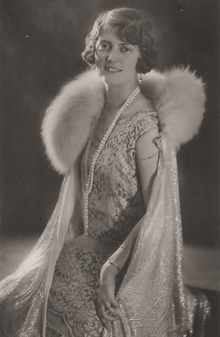Louisa Treniotis
This article is incomplete because it is pending further input from participants, or it is a work-in-progress by one author. Please comment on this article's talk page to share your input, comments and questions. Note: To contribute to this article, you may need to seek help from the author(s) of this page. |
| Louisa Treniotis | |
|---|---|
 | |
| Empress of Sunrosia and her constituent realms | |
| Reign | 25 December 1921 – 8 January 1922 |
| Predecessor | Adalbert XX |
| Successor | Monarchy abolished |
| Chancellor | Kaspar von Stenhofen |
| Born | Louisa Johanna Georgiana Theresa Elisabeth 30 November 1914 Coerz, Grand Duchy of Sunrosia, Sunrosian Monarchy |
| Died | 5 July 2010 (aged 95) Spálgleann, Caldia |
| Spouse | |
| House | Windenheim-Treniotis |
| Father | Adalbert XX |
| Mother | Sylviane of Gaullica |
| Religion | Solarian Catholic |
| Occupation | Linguist, author |
Louisa Treniotis (born Louisa Johanna Georgiana Theresa Elisabeth; 30 November 1914 – 5 July 2010) was the second female and final ruler of the Sunrosian Monarchy and and all of its constituent states for fifteeen days as Louisa. She took the name of Louisa Treniotis after her abdication, by which she become known for her her work on sign languages, particularly on the Swetanian general sign language, and her disability rights activism. Louisa became internationally known as "the Fortnight Queen" following the publication of her eponymous first autobiography in 1955.
Born with congenital muteness, Louisa was the only child of Adalbert XX and Sylviane of Gaullica and was merely seven when she succeeded her father following his death on 25 December 1921. Ascending to the throne in the midst of the Swetanian Revolution at a time by which most cities have already been lost to revolutionary forces, Louisa reigned only nominally as Empress for before the proclamation of the Panswetanian Council Republic brought an end to monarchical rule. She fled the country with her mother and close family members, first to neighbouring Werania and then to Caldia.
In exile in Caldia, Louisa continued her education and earned a Master of Arts degree from the University of Spálgleann. From 1930, she also attended Saint Agathe's School for the Deaf where she learned Caldian sign language and later met Deirdre Ní Síoda, who became her interpreter. Having no interest in her restoration to the Sunrosian throne, she formally abdicated and renounced her claims on 9 January 1936 and remained in Caldia to continue her research on sign languages, eventually getting awarded with a PhD in linguistics in 1946. Louisa married Ní Síoda on 24 August 1941.
Louisa returned to her homeland (now Swetania) in 1957 after relinquishing her last noble titles, the first member of the former House of Windenheim to be allowed to do so. Continuing her linguistic work here, she was a member of the Committee for a Common Sign Language responsible for the standardisation of the Swetanian general sign language in the 60s. Louisa also became a prominent voice for the rights of people with disabilities in Swetania, as well as an advocate for cordial Caldo-Swetanian relations. She permanently returned to Caldia in 1999, where she died eleven years later.
